|
|
Pharis

|
|
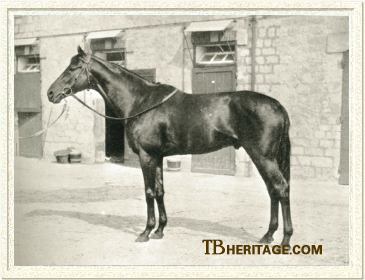 |
|
|
Pharis was a superb racehorse and champion sire in France. His career on the turf and in the breeding shed was seriously affected by World War II: the outbreak of war in 1939 put an end to his planned fall season on the racecourse in both France and England, and he lost almost five seasons as a stallion in France when he was confiscated by the Nazis and taken to Germany.
Pharis' dam, Carissima (1923), bred by Marcel Boussac, was out of an Irish-bred mare, Casquetts (by Captivation), and by Clarissimus, a winner of the Two Thousand Guineas that was sold to France after three years at stud in England. Clarissimus got a good winner in Nino, who took the prix du Cadran and was later a pretty good sire in France, and the Italian Guineas winner Delleana, later a superior brooodmare. But Clarissimus was most known as a broodmare sire whose grandchildren included Pharis and the French stallion Brantôme.
Carissima was a moderately successful winner of three races, the Prix de Sablonville and Prix de Malleret at Longchamp, and the Prix de Minerve at Evry, and was second, by five lengths, to Dorina in the Prix de Diane. She bred eight winners from twelve foals for Boussac, some of which were born in England after the start of the war. In addition to Pharis she bred Carius, a winner of some races, including the Prix Berteux; Caprifolia (winner of eight races and later dam of The Solicitor); Torissima, a winner of seven races and second dam of Tetrarch Stakes and Zetland Gold Cup winner Tale of Two Cities and of Djenne (later dam of the U.S. handicapper and stallion Olden Times); and Libération, that became the dam of Emperor (Prix Robert Papin and Dewhurst Stakes) and the outstanding stayer Elpenor (Prix du Cadran and Ascot Gold Cup).
In 1935 Boussac put Carissima to Pharos, a superior middle-distance horse at age four in England that stood at stud at Haras d'Ouilly in France after several years as a stallion at Woodland Stud in Newmarket. The year Carissima was bred to Pharos, a mare owned by Federico Tesio dropped a handsome bay colt to the cover of Pharos named Nearco, who was, like Pharis, a champion runner, and was to become one of the most influential stallions of the twentieth century. Pharis, while a very successful stallion in France with sons that went to every continent, would, in the long run, not prove as important in thoroughbred breeding.
Pharis eventually reached 16.2 hands in height. Although listed in some sources as "brown or black," a contemporary turf writer who visited described him as black "as a crow." This same writer, who interviewed Boussac's stable manager while gazing at Pharis, was very impressed by his presence and calm temperament, although Pharis had been known to nip a groom when he removed a water bucket too quickly "to his liking." He spent some time in a mild restraint to prevent him from chewing at his flanks, but was calm and professional on the racecourse. Pharis had a good, sloping shoulder and powerful hind end, but was long in the back and slightly back in the knees.
Pharis on the Turf
Pharis was placed in training with Boussac's private trainer, A. Swann. He did not run as a juvenile, a strategy Boussac and Swann seemed to follow for big, growthy colts, including several of Pharis' offspring in later years. He ran only three times in his life, and was unbeaten, at age three. What would have been his fall season was interrupted by the war: the Prix de l'Arc de Triomphe, slated for October 8th, was cancelled, and the Doncaster St. Leger in England, where Pharis would have met the champion English colt Blue Peter, was also abandoned that year. The interruption by war of the brilliant career of a French racehorse recalled the champion Sardanapale's career a little over twenty years before.
Pharis started his season in late May by easily winning the Prix Noailles at Longchamp (1-1/2 miles), beating the favorite, Foxhound, by three lengths. In early June he ran with thirteen others in the Prix du Jockey Club. The race started in a heavy rain downpour, and Pharis' pacemaker, Horatius, went to the front, while Pharis lay back at the tail of the field. As he moved up he was checked when he ran into interference, and as the horses passed the stands he turned on his amazing speed, successively passing each horse, and running down the leader, Galérian, to win by two and one-half lengths. It was a brilliant, thrilling race that made Pharis a hero and gave Boussac his fifth Prix du Jockey Club win.
Pharis' final performance was his dramatic win of the Grand Prix de Paris at Longchamp on June 15 (15 furlongs) in heavy, holding ground due to rain. There were seventeen colts and two fillies in the field, including Horatius, who set the pace at the start; Pharis was at the end of the pack for the early part of the race, and then four hundred meters from the post, was boxed in behind already beaten horses and nearly went to his knees, but as soon as an opening appeared on the rail, his jockey, C. Elliott, sent him through and Pharis came thundering down the stretch, "liked the winged horse of the Arab legend," putting away his opponents by two and one-half lengths. This was Boussac's first Grand Prix du Paris triumph. Pharis was acclaimed the champion of his year, and many compared him to the great French hero, Gladiateur.
Pharis in the Stud
Pharis was retired to Haras Fresnay-le-Buffard, where he was a successful, versatile stallion. He got four winners of the Prix du Jockey Club (French Derby), champion juveniles and champion three-year-olds of both sexes in France, terrific stayers that won the Doncaster St. Leger (two), the Prix Royal-Oak (French St. Leger), the Prix de l'Arc deTriomphe, the Prix Kergolay, and other distance races, a champion filly in Germany, and more than one winner in England of the Champion and Hardwicke Stakes. He was the leading sire of juveniles in France four times, and topped the general sires list in 1944, was third four times, and fourth once (when one factored in his winners beyond France, he was leading sire in 1944, 1950, 1951, and 1952). He was second on the list of leading broodmare sires twice, in 1955 and 1956.
Boussac bred and raced most of Pharis' successful offspring, and contingents of Pharis youngsters regularly made the channel crossing to run and win in England, where purses were much higher than in post-war France, and the glory certainly more prestigious at the time. Their successes, both in England and France, contributed to Boussac's placing at the top of the breeders lists in France for years, and to his reputation as the most successful of French breeders of the twentieth century. Up until Pharis' death at Haras de Fresnay-le-Buffard in February of 1957, he had bred 47 stakes winners and a total number of 108 individual winners of 285 races valued at £308,000, despite losing 4-1/2 years of breeding in France when he was confiscated by the Nazis and taken to Germany. Pharis was seldom put to outside mares (except for his time in Germany), in fact he was most often bred to daughters of Boussac's stallions Astérus (hugely contributing to his reputation as a broodmare sire) and Tourbillon, and one does wonder what he might have effected had that not been the case.
Pharis sons were extremely popular as stallions, and they spread his genes all over the world. They went to stud in Great Britain, South Africa, South America, Italy, New Zealand and Australia, the United States, and eventually, Japan. Although most were only moderately useful, some became champion sires that established long-lived tail male lines to Pharis. Not one of his sons that remained in France ever made the top ten in the sires list, but Pardal, who went to stud in England, was several times in the top ten there, and second in 1961, and he, along with Ardan, who stayed in France for a few years, were the two sons that established the longest-lasting sire line branches . Pharis daughters were only moderately successful broodmares on the whole, but a number of them bred on.
A number of his youngsters were similar in type to himself, over 16 hands with excellent shoulders, good bone and long backs, and not a few were back at the knee like his sire, Pharos. Many of his best runners exhibited his same game qualities and a run-from-behind style of racing. A few went wrong in the wind, giving Pharis an undeserved reputation as a sire of roarers.
|
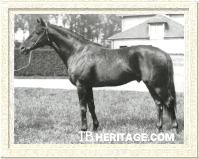
Pharis as a stallion
| |
In August of 1940, after just one season at Fresnay-le-Buffard, Pharis was one of the first horses to be confiscated by the Nazi invaders and transported to Germany, where he was placed at Heeresgestut (the German army's stud) at Altefeld in Hesse. There he was bred to both German mares and French mares that, like him, had been removed from French studs and shipped to Germany. The full extent of this disaster was not appreciated until 1944, when, out of his first crop of thirteen live French foals born in 1941, while he was in Germany, there were eleven runners and of those, ten winners of 48 races. His best from this year were ARDAN, PRIAM, PALENCIA and PHIDIAS, and their wins sent him to the top of the list of sires of juveniles in 1943 in the rackety depth of wartime racing in France, and to the top of the general sires list in 1944 when they were age three.
|
| ARDAN was a member of Pharis' first crop and was his sire's best runner, and one of his more influential sire sons. He extended the Pharis sire line into the late 20th century with his great-great grandson in tail-male, Hard to Beat, winner of the Prix du Jockey Club and later sire of a Prix de Diane winner. ARDAN was bred by Boussac, out of his excellent broodmare Adargatis, by Astérus. Adargatis, bred by Lord Clonmel in France and purchased by Boussac, was Boussac's first winner of the Prix de Diane. Like many Pharis youngsters, ARDAN was good at age two and later proved to be a top stayer.
|
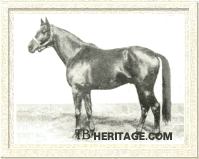
Ardan
| |
ARDAN was a top juvenile and champion at age three in France for Boussac, winning the Prix Greffulhe, Prix Lagrange, Prix Hocquart, Prix du Jockey Club, the Prix Lupin, and the Prix de l'Arc de Triomphe (although first past the post in the Grand Prix de Paris, he was penalized for weaving and interfering, and sent back to third place). In 22 starts in France he won fifteen times, was second four times, third twice, and was unplaced only once, running fourth. Racing in England only once, he won the Coronation Cup.
|
While he had natural talent, it was his courage that pulled him through in many races, where he would engage in close battles for the lead in the final furlong. He stood for three seasons at Haras Fresnay-le-Buffard, where he was a better than useful sire of 17 winners in France and 11 winners in England. In 1949 Leslie Coombs II purchased him for $400,000 and brought him to the U.S., where he was syndicated, but he never really fired as a stallion there, getting only a few good winners and a number of minor ones in his ten years at stud in that country. He died at Spendthrift Farm, Kentucky, in 1959 after a series of heart attacks.
In France and England ARDAN got Damarka, a winner of the Prix Malleret, Prix de Flore, and Prix de Marseille at age three, rated as the second-best filly of her generation. Another daughter, Dacia, became the champion juvenile and three year old filly in Italy. His son Ker Ardan won several races and was later a good sire in Uruguay, and another son, Guardian, shipped to the U.S., became a top turf horse, winning the Hialeah Turf Cup and 14 other races. But his best offspring was the consistent Hard Sauce (1948, out of Saucy Belle by Bellacose), a good juvenile and one of the best sprinters of 1951 and winner of the July Cup and five other races. Hard Sauce was later sire of Epsom Derby winner Hard Ridden (1955) and of Hard Tack (1955), the latter sire of both the English and Irish Two Thousand Guineas winner Right Tack and of the good runner Sparkler. Hard Ridden got Gold Cup winner Hardicanute (1962, later a champion broodmare sire in England), sire of Prix du Jockey Club and Arc winner Hard to Beat and dam's sire of Shirley Heights. Both Hardicanute and Hard to Beat ended up as stallions in Japan, where they had some influence. Sparkler later got some really good runners, including champion German juvenile Aspros, Oaks winner Scintillate (1976), and One Thousand Guineas winner Enstone Spark. In the U.S. ARDAN'S best foals were Frizette Stakes winner Indian Legend, Canadian Oaks winner Miss Ardan, and the good grass horse Lychnus. |
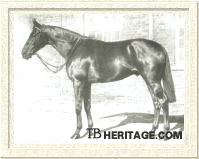
Priam
| |
PRIAM (1941) was a leggy brown mid-distance colt in that first crop of Pharis', out of the Astérus daughter Djezima, and bred and raced by Boussac. Like his grandsire, he was back at the knee. He won the Grand Critérium and other races as a juvenile, making him the champion two year old of 1943. He was sick, off and on during 1944, and ran only four times, winning the Prix de Acacias at a mile and the Prix Jacques Le Marois by a neck. The next year in England, 1945, he was in poor shape when he contested the Champion Stakes (10 furlongs), the first horse to run in England since 1941, but still was barely beaten by Court Martial in a thrilling race.
|
At age five he won the Prix de la Seine over 1-1/4 miles at Longchamp, and in England, carrying 9 st-12 lb won the 1-1/2 mile Hardwicke Stakes, beating Anwar (7 st-7 lb) and two others in heavy going. He was last of four to Airborne in the Prince of Wales's Stakes over 1-1/2 miles, having "gone stale." In all he won ten races in England and France.
PRIAM was retired to stud at Fresnay at the end of the 1946 season. In 1959 a Kentucky syndicate that included Henry Knight and Edward Moore brought him (and three other French stallions -- Goya, Hierocles and Adaris) to the U.S. Before he left France he got a Prix de Diane winner in Stratonice (1948) and another good filly in Simonetta (Prix Penelope, Prix des Reservoirs), and in the U.S. got a few good winners, including Landlocked (Widener Handicap, Atlantic City Turf Stakes), Troilus (Flamingo Stakes and others) and Cousin (Great American Stakes, Flash Stakes, Hopeful Stakes, Saratoga Special).
Pharis' daughter PALENCIA (1941), from Hestia, by Tourbillon, also bred and raced by Boussac, was another outstanding juvenile from Pharis' first crop, champion juvenile filly of 1943. She won the Poule des Deux Ans, and two other races in succession, and at age three the Prix Vanteux, leading up to her win by 1-1/2 lengths of the Poule d'Essai des Pouliches. After that she injured herself, and was retired to stud where she got good runners in Targui, Altana, and Arbencia, the latter a winner of the Prix Vermeille. Dankaro, a good multiple stakes winner of the early 1970s descended from PALENCIA.
|
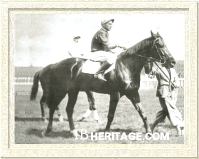
Pheriphas
| |
PHERIPHAS (1941), was a brown horse out of Albarelle, by Kantar, bred by Boussac. Albarelle was also dam of Caravelle (by the Astérus son Abjer), Boussac's winner of the Poule d'Essai des Pouliches and the Prix de Diane. PHERIPHAS injured himself and did not start until age four, when he won twice in seven starts, including the Prix de Cheffereville over 10-1/2 furlongs. At age five he won the Prix Barbarelle at Longchamp (1 mile-7 furlongs), but could only place fourth in La Coupe and the Prix la Rochette (2 miles-4 1/2 furlongs). In 1947 he was purchased by a syndicate of South African breeders and sent to stand at stud at Rathgar Stud. Not a particularly successful runner, he was even worse as a sire.
|
The other good ones in Pharis' first crop included PHIDIAS and PHARELLE. PHIDIAS, from Loika, by Gay Crusader, another good juvenile, won six races, including the Poule des Foules, the Prix des Acadias, and the Prix de St. Gatien; he did not run in the classics, but he won the Prix de St. Mihiel at Longchamp in 1944, the year the Nazis re-opened the course, and was second behind PRIAM in the Prix Jacques le Marois. He was sold to Argentina, where he was a successful sire, getting Precinta, the champion filly in Argentina, and Imprevisto, the champion three year old in Venezuela, and Pretexto, a good winner of seven races -- including the clásicos Carlos Casares, San Isidro and General Belgrano-- and later a more than useful sire in Argentina.
PHARELLE, from the Tourbillon daughter Sameya, won three races; she was later dam of Prix Robert Papin winner Pharel. NORMANDIE (1941, Chope du Nord by Tom Pinch) later produced Prix Lagrange winner Nordic. Another filly, DAOVA (1941, from Mahatma by Astérus) won two races.
The German Interregnum
It is not clear just how many foals Pharis got in Germany. Boussac would not sign birth certificates for any foals born in Germany, and his foals born from French mares taken to Germany and later recovered were listed in the French Stud book with an "X" as their sire. He had four and one-half seasons in Germany, his first crop two year olds in 1943, and the bulk of them maturing in 1944 and 1945 when racing in Germany was practically non-existent. One of his last foals in Germany was the filly ASTERBLUTE, born in 1946 from the Oleander mare Aster. She ran for Baron Waldemar von Oppenheim's Schlenderhahn Stud, that had been expropriated by the Nazis and returned to him in 1948, after some years of wrangling with the Allied Forces that had liberated Altefeld (some of his offspring were taken as war booty by the Allies). As a three-year-old in 1949 Asterblüte was one of the best of her generation, winning the Schwarzgold-Rennen (One Thousand Guineas), the Preis der Diana (Oaks), the Union-Rennen, and the Deutches Derby, and placing second to her stable-companion, Aubergine (also owned by Oppenheim) in the Henkel-Rennen (Two Thousand Guineas) and the Deutsches St. Leger.
|
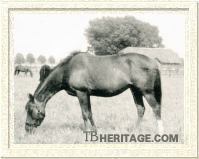
Varinas (1945, Valetta, by Tourbillon) was a Pharis filly bred in Germany from the stolen Boussac mare Valetta; post-war she was a broodmare in the Gestüt Werne
| |
Another Pharis foal bred in Germany was SERRE CHAUDE (1944), from Vanda Teres, by Blandford, a mare confiscated from the Rothschild's Haras de Meautry. Repatriated to Meautry, she was one of the Pharis foals refused registration by Boussac. Nonetheless, she was used as a broodmare while Edouard de Rothschild fought to resolve the registration issue. In 1951 she bred a daughter, Hot Stuff (by Brantôme), later dam of Hildegarde, winner of the Prix Chloe, and in 1953 produced a bay colt, Verrieres, to the cover of the Two Thousand Guineas winner Palestine. He was the champion juvenile colt in France. He proved to be a sprinter, and at age three he won the Prix de la Porte Maillot and in Italy the Premio Chiasura, and was second behind PHILIUS in the Prix Djebel. At age four he won the Prix de la Jochère. He was later a stallion at Georges Wildenstein's Haras de Victot in Calvados, and got good winners in France and Italy.
|
Pharis' other German offspring that were of any use on the turf were Alexey, Anskar, Chorcherr, Liebesgott, and a filly, Quarry, that won the Polish Oaks.
Back in France
Pharis was repatriated towards the end of the 1945 breeding season, in May, and reinstalled at Boussac's stud. He covered a few mares in France that year, including Adargatis, the dam of ARDAN and PARDAL. The next year she dropped GABADOR (1946, properly by Djebel or Pharis), winner of his only start, the Prix des Dahlias (2,000 meters). In 1951 he was sold to New Zealand, and spent seven seasons at W. Fisher's Ra Ora Stud, where he got winners in both New Zealand and Australia, including the champion sprinter and Doomben Ten Thousand winner El Khobar, Auckland and Brisbane Cup winner Apa, Auckland Cup winner Marie Brizard; he was also dam's sire of the New Zealand champion Kirrama. In February of 1962 he was shipped to Japan where he sired Yasuda Kinen winner Panasonic, Fine Port, and other good runners. GABADOR died in 1973.
Pharis' first full French crop after he was back home were foals of 1947; they included SCRATCH, a Prix du Jockey club winner; CORREJADA, winner of the Poule d'Essai des Pouliches, and the Irish Oaks, among other races; and PARDAL, a successful mid-distance runner and good sire in Great Britain.
|
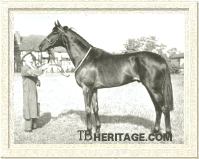
Pardal
| |
PARDAL (1947), was out of Adargatis, and so brother to ARDAN and GABADOR. Pardal did not start racing until age three, and showed only moderate form, running second in the Prix Juigne, and third in the Prix Hocquart and the Irish Derby for Boussac. But the next year he improved dramatically, becoming one of the best mid-distance horses in Europe, winning at distances between 10 and 14 furlongs in both England and France. He started in France by winning two minor races, then Boussac took him to England, where he ran second in Ascot's Hardwicke Stakes. After that he won the Princess of Wales's Stakes (making all the running), the Great Yorkshire Stakes, the Jockey Club Stakes and the Lowther Stakes in succession.
|
PARDAL was purchased by an English syndicate and stood at the Lanwades Stud at Newmarket until 1965, when, past his prime, he was sold to Robin McEnery, a Newmarket vet and sent to his brother's stud at Rossenarra, Kells, Co. Kilkenny, in Ireland, where he died in May of 1947 from a heart attack after successfully covering a mare.
PARDAL started his stud career in England with a bang, getting four stakes winners that put him at the top of the freshman sire's list in 1955. With two crops running, he went to seventh on the leading sires list, and third on the list of juvenile sires. In 1958, supported by his sons Derby winner Psidium, another classic-level colt Pardao (third in the Derby, later winner of the San Juan Capistrano Handicap in California), St. James Stakes winner Dalsea, and other good runners, he rose to second in the leading sires list in England. His other good runners over the course of his stud career included the filly Pardala, sent to the U.S. and winner of the Black Helen Handicap Stakes; the good juvenile Eudaemon (Gimcrack Stakes, Champagne Stakes, Column Produce Stakes); the miler Firestreak (City and Suburban Handicap and other races); Street Cry (winner of the Cambridgeshire); the good stayers Parbury (five wins, including the Ascot Gold Cup, second in Goodwood Cup and Jockey Club Cup) and Pardallo (a winning hurdler and then the best stayer in Europe, winning the Ascot Gold Cup, Prix Kergorlay, Prix Jean Prat and two other races); and Decies, winner of the Curragh's National Stakes as a juvenile and of the Irish Two Thousand Guineas at age three.
Many of PARDAL'S offspring went abroad to race, winning over 500 races. Parsing won the Clásico Jockey Club del Peru and a number of other good races; Pa Bear took the prestigious Queen Elizabeth Cup in India; Paradoxe won the Grand Steeple-Chase d'Ostende, and other colts and fillies won big races in Norway, Sweden, and Italy. Pardal also got some good jumpers that won hurdles and steeplechases.
PARDAL'S Derby-winning son, Psidium (1958), despite reaching second on the English sires list when his game son Sodium was age three, was a disappointing sire, both in England and later in Argentina. He got Irish Derby and Doncaster St. Leger winner Sodium, later a modest sire; Goodwood Cup winner Richmond Fair, and Presidial that won good races in Canada and the U.S., but none of these did much in the stud. PARDAL'S staying son Pardallo (1963) was sold to France and then to Argentina, where he got some good stakes winners, including Janus, a winner of the Grande Premio in Brazil, and later a successful sire there. Parbury (1963) also went to South America, where he was a sire of stakes winners in Chile. Pardao (1958), who had won races in California as an older horse, went back to England where he was the leading freshman sire, and got Funny Fellow and Spoiled Lad, both minor stakes winners that went to stud in New Zealand and Australia respectively. Parsing, a winner in Peru, was a leading sire there.
PARDAL'S best sire sons were the speedy Decies (1967), the miler Firestreak (1956) and Paresa (1955), a very modest winner in England of two races. Decies went to stud in New Zealand, where he got the great Australian horse of the year, Dulcify and the good classic winner Lefroy, among other stakes winners; Decies was later a moderately successful broodmare sire. Firestreak got Epsom Derby winner Snow Knight (1971), later sire of some good fillies, including Champion Canadian filly Northern Blossom and Yorkshire Oaks winner and stayer Awaasif, and was later broodmare sire of Epsom Oaks winner Snow Bride. The modest Paresa (1955) went to Chile, where he was on the leading sires list six times; his best were the champion three-year-old colts in Chile, Prologo and Par de Ases, and the champion Chilean filly Plegada. Prologo and Par de Ases were later successful sires in Chile.
|
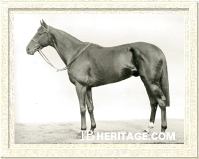
Scratch
| |
Boussac's SCRATCH (1947), a chestnut, was out of non-winning Orlamonde, by Astérus; Orlamonde was a sister to Boussac's good stayer and stallion Jock. She bred three good winners in addition to SCRATCH, including JANITOR (1950) and a half-brother, Damnos, that was a good sprinting winner of eight races in France, including the Prix d'Arenberg, and one race in England. SCRATCH was shipped to England to run once as a juvenile, in the Solario Stakes at Sandown (7 furlongs), which he won easily by two lengths, beating winners Flying Slipper and Stella Polaris and marking him out as a future classic contender.
|
At age three in France, he first started in Longchamp's Prix de Guiche, beating Fort Napoleon by a neck. Next up was the Prix Greffulhe, where he beat nine good runners, and then he was second, by two lengths, to Lacaduv, in the Prix Noailles. His next race was the controversial 1950 Prix du Jockey Club, which he took by a short head, beating Tantième, a horse many thought had won. His next race was the Grand Prix de Paris, but he was fourth, behind Edouard de Rothschild's Vieux Manoir and two others. The next race was across the channel: the Doncaster St. Leger, and his primary opponent was Vieux Manoir, but close to the finish line Scratch turned on the speed, and beat the Rothschild colt by a length. Back in France, SCRATCH ran in the Prix de l'Arc de Triomphe, but could only place fourth to Tantième and two others.
At age four SCRATCH ran three times. In France, he beat future Ascot Gold Cup winner Pan, a French horse full of Boussac breeding but not bred or raced by him, in the Prix Jean Prat (1 mile-7 furlongs). In England SCRATCH ran unplaced in Pan's Ascot Gold Cup and the King George VI and Queen Elizabeth Stakes. He was then retired to Fresnay-le-Buffard as a stallion.
In France he got Dushka (1955), a winner of the Prix de Diane, the Grand Prix of Baden-Baden, and the Prix Penelope, Tarquin (1955), the champion juvenile of his year in France and later sire of Giquin, a Grand Steeple-Chase de Paris winner, and several other good ones. In 1955 he was auctioned to Argentina for £52,500, where he got some good runners and had a significant influence on Chilean breeding through his son Scelto, the latter champion sire in Chile three times. His other good runners in South America included Scare Face, winner of the Polla de Potrancas at La Plata, and other races, and Snatch, that won the Clásico Provincia de Buenos Aires (2300 meters, at La Plata), and he was dam's sire of the Peruvian champion runner Dare.
|
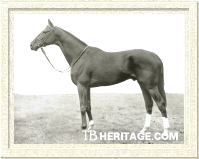
Talma
| |
The chestnut TALMA (1948), out of the Astérus mare Thaouka, was another handsome Boussac-bred colt that could go a distance. Thaouka had won the Grand Prix de la Ville de Vichy (1 mile-5 furlongs) and two other races, and later bred four other good winners, including Talma's sister CARAMIDA (1947), that won the 1950 Newmarket Oaks. TALMA did not run as a juvenile, and at age three was unbeaten in the four races he contested: the Prix Franc Tireur (Le Tremblay, by two lengths) and the Prix Berteux (beating Le Capricorne) in France, and in England convincingly won the Doncaster St. Leger by ten lengths, coming from behind and beating Derby winner Arctic Prince and other good ones ("Made his rivals look like donkeys."). His second race in England that year was the Cumberland Lodge Stakes over two miles at Ascot, which he won by a neck, giving him a reputation as being "lazy."
|
| TALMA had three outings at age four: he could only run second to Mat de Cocagne in the Prix du Cadran by 1-1/2 lengths, and then was third to Aquino and Eastern Emperor (who he had beat in the Cumberland Lodge Stakes), 2-3/4 lengths behind the winner. His third race was the Doncaster Cup, where he ran fourth to Aquino. He ran twice at age five, taking the Prix Flying Dutchman (2600 meters, beating STYMPHALE), but back in England was seventh of ten in the Ascot Gold Cup, won by Souepi. In this race, Pharis' son ARAM (1949, from Esmeralda by Tourbillon) had been entered by Boussac as a pace-setter for TALMA and unexpectedly did very well, leading almost wire to wire and barely beaten into second place in a photo finish (he won three other races in England and was later a sire of good Brazilian stayers from his base at Puesto de Montas de São Paulo).
|
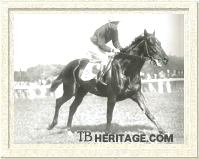
Auriban
| |
AURIBAN (1949) and PHILIUS (1953) were both Prix du Jockey Club winners for Boussac. They were both out of Tourbillon daughters: AURIBAN was a brown colt, very typical in the stamp Pharis put on most of his youngsters. He was at or near the 3 year old championship (depending on the handicapper; he did not run in the fall races) out of Arriba, a non-runner and sister to Boussac's Prix du Jockey Club winner Cillas. PHILIUS, more of a speedster whose career was cut short by injury, was out of Theano, a modest winner of her only race at age two, and of the Prix Maurice de Gheest at Deauville (1400 meters) at age three.
|
AURIBAN was a very impressive juvenile, winning four of his five races and the juvenile championship in France. He won his debut race in late June, then easily won the Prix Robert Papin (1200 meters) and the Prix Morny (1200 meters), but only ran fourth in the Grand Critérium; taken to England he won the Houghton Stakes.
At age three, not nominated to the English classics, he did all his racing in France, where he was indisputedly the best in the spring races. He started in the Prix Greffulhe at Longchamp (2100 meters), where he lost ten lengths right at the start, due to jockey error; he made up a terrific amount of ground, but could not quite catch Silment, who beat him by three lengths into second place. Next was the 2400 meter Prix Hocquart at Longchamp where, once again trailing the field by 15 lengths, he got up to pass the leader, Worden, and win by half a length. He did not run again until the Prix du Jockey Club, where he beat twelve others by three lengths, despite, once again, mucking about at the start and losing ten lengths to the rest of the field, catching up without whip in a thrilling performance and in the best time in the race since 1905. He was Boussac's tenth winner of the Prix du Jockey Club. He ran once more, in the Grand Prix de Paris, where he plunged ahead of his pacemaker, and could not stave off a last minute challenge by the good Fair Copy colt, Orfeo, and so ran second by two lengths. He did not race again, with rumors that he went wrong in the wind.
He was a disappointing stallion, getting nothing that approached his quality, his best probably Gaulois, a winner of the Goodwood Cup, and Anagram, winner of the Prix Eugene Adam, and later a stallion in Brazil. He died fairly young, in 1963.
|
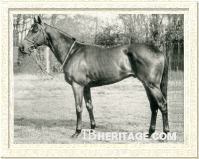
Philius
| |
PHILIUS, the fourth and final Prix du Jockey Club winner by Pharis, was ranked second on the Free Handicap for juveniles, behind Apollonia, a grandaughter of Pharis' through his excellent running daughter COREJADA. At age three he made his debut in the Prix Djebel at Maisons-Laffitte (1600 meters), which he won in a fast kicking finish by three lengths. Boussac took him across the channel to run in the Two Thousand Guineas, where he ran fifth; he was slated to run in the Epsom Derby, but Boussac pulled him out to replace an injured stablemate, Floriados, and sent him back to France to run in the Prix du Jockey Club, to be held four days later. Although starting only fifth favorite, Boussac's judgment proved sound when Philius, staying near the leaders, got up to win by two lengths, beating a good field of fifteen others in heavy going, with Tanerko third.
|
PHILIUS did not run again until the Grand Prix de Paris, where he just could not stay, finishing fifth. His last race was the Prix Jacques de Marois (1600 meters at Deauville), where he ran unplaced, and shortly thereafter he injured himself, terminating his career on the turf.
PHILIUS got some good runners in France, including the good stayer Siberie (Prix du Cadran and Prix de Longchamp), and Trenel, winner of the Prix Reiset and second in the Prix du Jockey Club and later a good sire of jumpers including two Grand Steeple-Chase de Paris winners. In October of 1964 he was sold to Japan, where he got a number of good winners, including Ryu Tokistu and New Kiminonaha. He died in 1977.
|
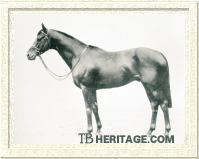
Dynamiter
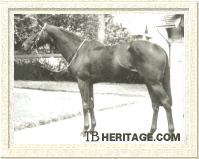
Pharsale
| |
Other good racing sons by Pharis included the black stayer STYMPHALE (1948, from Tanis, by Tourbillon) a winner five times -- and placed second four times -- in twelve starts, including the Prix Juigne (2100 meters, by five lengths), the Prix de l'Esperance (3,000 meters), and the Prix Royal-Oak (also by five lengths), and other races; the powerful, classy brown DYNAMITER (1948, out of Pretty Lady, by Umidwar), who took five races, including the Prix d'Ispahan (1-1/2 miles), and in England the Champion Stakes (in a canter by six lengths), among other races; PHARSALE (1948, out of Alcine, by Abjer), the second best colt in France at age two, winner of six races, including the Prix Robert Papin, Prix de la Forêt, the Prix la Rochette and the Coupe at Maisons-Laffite twice; JANUS (1947, from Thiorba (winner of five races), by Banstar), a big brown colt that as a juvenile won the Prix de Chateau at Chantilly and the Prix la Rochette at Longchamp, and was second to Fontaine in the Prix Herod, giving him ten pounds, and at age three, in his only start, won the Prix Jean Prat (10 furlongs); CORTIL (brother to JANUS), winner of the Gimcrack Stakes in England.
|
PHARAD (1949, out of Savannah, by Jock), a top juvenile, was the winner of four races, including the Critérium de Maisons-Laffitte, beating the Grand Critérium winner Cosmos. JANITOR (1950, out of Orlamonde, by Astérus) won the Prix St. Firmin as a juvenile, was injured in the running of the Arc at age three, and at age four won the 2200 meter Prix du Prince de Galles and was second to Aureole in the Hardwick Stakes in England; he was later a sire in Italy. PHARASIS (1949, out of Isis, by Thor), was a moderately successful stayer that won the 5,000 meter Prix Rainbow at Longchamp. FAUBLUS (1950), took the Prix Daphnis (1600 meters) and Prix Noailles. ARTRAX (1957, from Sembrana, by Hyperion), won some good races as a juvenile and at age three the King Edward VII Stakes (12 furlongs) in England. There were plenty more Pharis stakes-winning sons, some of which were well-placed in the year-end rankings in France.
Pharis sons and grandsons went to stud in countries all over the world. In addition to those previously covered, his more notable sire sons included the following horses.
In South America, in addition to PARDAL'S son Pardallo and to SCRATCH and his son Scelto, FLAMBOYANT DE FRESNAY (1948, from Djezima by Astérus, originally called Flamboyant), a brother to PRIAM, became an influential sire in Brazil. He had been a promising runner for Boussac, but broke down after his second race and was sold to stud. In Brazil he got Golf, winner of the Grande Premio Presidente da República, later a sire in Brazil, the Grande Premios Diana winner Ginger, and other good ones. PHARAS (1948), a son of the great Astérus mare Astronomie, won the Prix du Lys and one other race, and was sacrificed, unsuccessfully, as a pace-setter for STYMPHALE in the Grand Prix de Paris; after that race, in which he "lost his breath," it was determined he was a roarer. Sold to Brazil, he was successful, ranking second on the sires list once. He got a number of classic winners and good stayers, inluding Zenabre (1961), a top runner and later five times among the leading Brazilian sires, Derby Paulisa winner Garboleto, and Nermaus, a winner and later sire in Brazil. AMPHIS (1949, from a Tourbillon daughter Coronis) also went to Brazil, where from his sole crop he got Hyperio, a good winner and himself a successful sire in Brazil that got some noted runners. Both ARAM (1949) and FAUBLAS (1950), noted earlier, went to Brazil; FABULAS was a leading sire whose winners included the clásicos winner Olesko, and the good stayers Neocadia and Ricardo A. FREQUENCY (1949, out of Invisible, by Astérus) went to Peru, where he reached second in the leading sires list, and PHARE (1948, out of Melusine, by Mahmoud) was a sire of stakes winners in Venezuela.
|

Janus
| |
Several Pharis sons went to stud in South Africa. Of these, the good juvenile runner JANUS (1947), who broke down after his successful run in the 1-1/2 mile Prix Jean Prat at age three, was purchased for South Africa by H. Oppenheimer for a record sum in 1950 and put in his Mauritzfontein Stud at Kimberly. He was moderately successful, getting two South African Derby winners, Tiger Fish and Open Sea, and South African Oaks winner Dame de Coeur. The brown PHERIPHAS (1941), as noted earlier, also went to South Africa where he got a few stakes winners, as did ALCINAS.
|
In addition to GABADOR (1946), DAMTAR (1948, from Tharida, by Tourbillon) went to Australasia, where he got some stakes winners. He won the Prix de Blaison (5 furlongs) and was second in the Middle Park Stakes and third in the Dewhurst Stakes in England broke down before he could start in the Two Thousand Guineas at age three. As previously mentioned, ARDAN's tail-male descendants Hardicanute and Hard to Beat ended up as sires in Japan, as did, ultimately, GABADOR. PHILIUS also ended up in Japan, where he was a good stallion. ARDAN and PRIAM, as mentioned earlier, and CORTIL, eventually went to the U.S.
Pharis Daughters
In addition to the German-bred champion filly ASTERBLUTE and the French champion filly PALENCIA, Pharis got some other really good daughters that ran in France and England, primarily for Boussac.
|
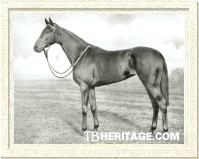
Corejada
| |
COREJADA (1947) was out of the Tourbillon daughter Tourzima, a winner of one race and in-bred to the sisters Durban and Heldifann. Because Tourzima was a daughter of Djezima, Corejada was a close-relative to PRIAM and his brothers. Corejada ran only in England as a juvenile and took all three of her races: the Findon Stakes at Goodwood, a race at York which she won in a canter by four lengths, and the Cheveley Park Stakes for juvenile fillies at Newmarket which she won in an authentic manner by a head from Diableretta, up to that point regarded as the best filly in England. Not listed on either the French or English freehandicap, she was actually the champion juvenile filly in England, based on her merits.
|
At age three COREJADA won the Poule d'Essai des Pouliches in France, was second in the Prix de Diane after being violently bumped during the running, and in Ireland, won the Irish Oaks, but giving away gobs of weight could only run second in the Yorkshire Oaks (she was not nominated to the English classics). Retired to Fresnay-le-Buffard, she became the dam of dual champion Boussac filly, Apollonia (by Djebel), winner of the Prix Morny and Grand Critérium as a juvenile, and the Poule d'Essai des Pouliches and the Prix de Diane at age three. Corejada also produced Macip (by Marsyas), a grand stayer that won the Prix Maurice de Nieuil, the Prix Kergorlay (3,000 meters), the Prix Royal Oak, and the Ascot Gold Cup; he was later a sire in Brazil. Through her daughter Capana (1965, by Abdos), COREJADA is fourth dam of the grand jumping mare Princesse d'Anjou (2006 Grand Steeple-Chase de Paris winner).
Other good Pharis fillies born in 1947 included CORSEIRA (La Circe by Ksar), an easy winner of the Prix Penelope after which she was retired, CARAMIDA (sister to TALMA), a winner of the Newmarket Oaks in England, and BLUE KISS (from Poule d'Essai des Pouliches winner Blue Bear by Blenheim), winner of five races, including the Prix de Pomone, and second in the Prix de Flore. BLUE KISS was a very good broodmare, producing Ivresse, winner in Germany of the Preis der Diana and the Schwarzgold-Rennen (later dam of Deutsches Derby winner Ilix and Preis der Diane winner Ipanema); Garde Coeur, winner of the Prix Daphnis, and three other daughters that bred stakes winners, including Cymbale, who produced the Gran Premio di Milano winner Beau Charmeur.
In the 1948 crop, MONROVIA (Geranium - Mahmoud) was Pharis' best running filly, although not Boussac's, who had the talented Djelfa (by Djebel) and Damaka (by Ardan) in his stable as three year olds of 1951. At age two she won the Prix de Saint Firmin, her only start, and as a three-year-old she won the Prix de Saint James, beating Djebellica, could not overcome a bad start in the Prix d'Essai des Pouliches, won the Prix Royamaunt easily, was second in Ascot's Ribbesdale Stakes, fourth in the Park Hills Stakes, and led from start to finish in the 13 furlong Prix de Royallieu. MONROVIA was tail-female ancestress of Groom Dancer (1984) and the Grand Prix de Paris winner Le Nain Jaune (1979). Other fillies in Pharis' 1948 crop were Prix de la Salamandre winner CATUMBO (Callais-Tourbillon), and MONTARIA (Sakountala-Goya), a half-sister to Hugh Lupus, who bred Mansour, one of the best of his age in Spain, winner of the Gran Premio Nacional (2400 meters) and other races.
In 1949 came PHARAOS (1949, out of the non-winning Goya daughter Palaos, and so closely related to PRIAM, Djeddah and COREJADA), the best juvenile filly of her year in France. She won the Poule des Deux Ans at Chantilly and the Prix du Bois at Longchamp, both over 1,000 meters. Taken to England, she ran second, by a neck, to Windy City in the Gimcrack Stakes at York. Back in France she won the Prix de la Forêt by three lengths, setting a new juvenile record for the distance. Also in this crop was PAREO (Theano-Tourbillon, and so sister to PHILIUS), winner of the Prix Chloe and Prix du Petit Couvert, and in England of the Princess Margaret Stakes. BALKIS (sister to CATUMBO) won the Prix des Reservoirs and was second in the Prix de la Salamandre.
In the early 1950s crops ADARCA (1950, Akra-Astérus) won once as a juvenile and was promising in the spring of her three-year-old year, winning the Prix Penelope, but she was not among the best fillies of her year. Some good juveniles from these years were ALBANILLA (1951, sister to COREJADA), winner of the Critérium Maisons-Laffitte, and her sister, FLORIANA (1956), a winner of the same race, and FAKAHINA (1952, Hypanis-Jock), who took the Prix Eclipse. Other Pharis daughters won various minor races at ages two and three.
Although he was second in the French broodmare sires list in 1955, Pharis was not an outstanding broodmare sire. In addition to the progeny of daughters already mentioned: PALEO (1953, Calonice-Abjer) was a good broodmare, dam of Curragh National Stakes winner Mystery (1959 by Milesian), later a stallion in New Zealand, and his brother Partholon (196), winner of the Curragh's National Stakes and second in the Anglesey Stakes and Doncaster's Gold Cup which ranked him second in the free handicap as a juvenile, and the Ebor Handicap at age three. Partholon was sold to stud in Japan, where he was leading sire in 1971 and 1976. ANYTE (1950 Theano-Tourbillon, sister to PHILIUS and PAREO) bred the lovely filly Ancasta (1961, by Ballymoss), winner of three good races, including the Irish Oaks and the Pretty Polly Stakes. Pharis daughters produced at least another twenty or so stakes winners, and many descendants are still winning today.
--Patricia Erigero |
|
|
|

